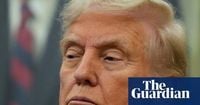As the United States government ground to a halt in early October 2025, a fresh controversy erupted—not over budget line items or legislative gridlock, but over a series of AI-generated videos posted by President Donald Trump. The videos, widely condemned as racist and inflammatory, featured House Minority Leader Hakeem Jeffries and Senate Minority Leader Chuck Schumer depicted in offensive caricatures, igniting a firestorm of criticism from across the political spectrum and putting the nation’s use of artificial intelligence in the political arena under a harsh spotlight.
On October 6, 2025, with the government teetering on the brink of a shutdown, Trump posted a deepfake video to his social media accounts. In the clip, Jeffries was shown wearing a digitally manipulated sombrero and a large mustache, set to the sound of mariachi music. Standing beside him was Schumer, whose AI-altered voice delivered a string of disparaging remarks about immigrants, Latinos, Black people, and transgender individuals. The video, as reported by indy100 and other outlets, was almost instantly met with outrage. Critics labeled it “racist,” “bigoted nonsense,” and “reminiscent of something a stupid middle school bully would do.”
The backlash was swift and severe. “Not only is the president sharing AI manipulated videos, but the videos are truly disgusting, racist, and grotesque. I am truly embarrassed to be an American right now,” wrote one critic, echoing a sentiment that reverberated through social media and newsrooms alike. Another observer remarked, “This vulgar AI video is not from a disturbed 12-year-old, it's from the president of the United States.” The timing only intensified the criticism—the video appeared just hours after shutdown negotiations collapsed, with only 48 hours left before federal funding ran out.
Rather than backing down, Trump doubled down. Less than 24 hours after the initial post, he shared a second doctored video. This new clip began with footage of Jeffries criticizing Trump’s earlier post, then cut to more altered footage of Jeffries in a sombrero and mustache, now accompanied by a mariachi band—each musician’s face replaced with Trump’s own. According to HuffPost, this escalation seemed calculated, a deliberate provocation at a moment when the nation’s leaders were supposed to be finding common ground to avert a government shutdown.
Jeffries, for his part, responded directly. Standing on the steps of the Capitol on October 7, he addressed Trump with a pointed message: “The next time you have something to say about me, don’t cop out through a racist and fake AI video. Say it to my face.” His words, reported by multiple outlets, were a call for accountability and decency at a time when the boundaries of political discourse seemed to be eroding.
The White House, meanwhile, offered little in the way of contrition. On October 8, Press Secretary Karoline Leavitt told reporters, “I think the president saw the video and posted it, and then took it down. And he has the right to do that. It’s his social media. He’s incredibly transparent, as you all know. You hear from him directly on social media. He likes to share memes, he likes to share videos, he likes to repost things that he sees other people post on social media as well and I think it’s quite refreshing that we have a president who is so open and honest.” The statement did little to quell the uproar, and the White House later said, according to Newsweek, that AI videos and memes portraying Democratic leaders in sombreros “will continue” until the government reopens.
Republican leaders appeared divided in their responses. House Speaker Mike Johnson, in a press conference on October 9, referred to Trump’s social media antics as a “sideshow.” He told reporters, “These are games. These are sideshows. People are getting caught up in — in battles over social media memes. This is not a game. We’ve got to keep the government open for the people. I don’t know why this is so complicated.” Johnson went on to address Jeffries directly, offering advice: “And to my friend Hakeem, who I was asked about: Man, just ignore it.” In a moment of levity, Johnson compared the episode to a recent video posted by California Governor Gavin Newsom, which depicted Johnson as a yellow minion from the animated film Despicable Me. “I mean, Gavin Newsom was trolling me last night. He painted me like a minion. He painted me yellow with big glasses and overalls. And I thought it was hilarious. You don’t respond to it ... Don’t respond to it,” Johnson said. “Get to work, do the people’s business, and let’s get on with it.”
Other Republicans, however, dismissed the controversy altogether. Vice President JD Vance told reporters on October 8, “The president’s joking! And we’re having a good time. You can negotiate in good faith while also poking a little bit of fun at some of the absurdities of the Democrats’ positions, and even poking some fun at the absurdity of the Democrats themselves.”
Yet the episode was only the latest in a string of recent incidents that have led observers to question the president’s judgment and mental acuity. Earlier in the week, Trump had reposted an AI-generated video promoting “med bed hospitals,” a rightwing conspiracy theory that claims secret medical technology is being withheld from the public. The video showed an AI-generated Trump promising that “every American will soon receive their own med bed card,” granting access to advanced healthcare. The post was later deleted, but not before fueling confusion and concern about the president’s grasp on reality. As The Guardian reported, Press Secretary Leavitt’s explanation—“He likes to share memes... and I think it’s quite refreshing that we have a president who is so open and honest”—did little to clarify the situation.
Trump’s recent public appearances have also raised eyebrows. In a speech announcing grants for autism research, he made confusing statements about Tylenol, pregnancy, and “certain elements of genius that can be given to a baby.” During a press conference with British Prime Minister Keir Starmer, he mixed up Albania and Armenia while discussing a peace deal—an error he repeated on Fox News. And, after posting about a tragic shooting at a Mormon church in Michigan, he quickly shifted his attention to a video about gold fixtures in the White House, leaving the public and the press puzzled by his priorities.
These incidents have prompted concern from both political opponents and nonpartisan observers. Retired General Barry McCaffrey told MSNBC that Trump’s recent performance was “one of the most bizarre, unsettling events I’ve ever encountered.” Democratic Congresswoman Madeleine Dean confronted Speaker Johnson, saying, “The president is unhinged. He is unwell.” Johnson, for his part, deflected: “Well a lot of folks on your side are too.”
As the government shutdown drags on and the nation’s leaders trade barbs—sometimes through AI-generated caricatures—the boundaries of political discourse, technological ethics, and presidential conduct are being tested in ways that would have seemed unthinkable just a few years ago. In the midst of crisis, the question remains: what, if anything, will bring the focus back to governance and away from the sideshows?

